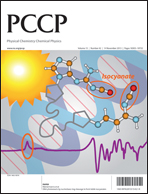Structural transitions of epitaxial ceria films on Si(111)
Abstract
The structural changes of a (111) oriented CeO2 film grown on a Si(111) substrate covered with a hex-Pr2O3(0001) interface layer due to post deposition annealing are investigated. X-ray photoelectron spectroscopy measurements revealing the near surface stoichiometry show that the film reduces continuously upon extended heat treatment. The film is not homogeneously reduced since several coexisting crystalline ceria phases are stabilized due to subsequent annealing at different temperatures as revealed by high resolution low energy electron diffraction and X-ray diffraction. The electron diffraction measurements show that after annealing at 660 °C the ι-phase (Ce7O12) is formed at the surface which exhibits a  structure. Furthermore, a
structure. Furthermore, a  surface structure with a stoichiometry close to Ce2O3 is stabilized after annealing at 860 °C which cannot be attributed to any bulk phase of ceria stable at room temperature. In addition, it is shown that the fully reduced ceria (Ce2O3) film exhibits a bixbyite structure. Polycrystalline silicate (CeSixOy) and crystalline silicide (CeSi1.67) are formed at 850 °C and detected at the surface after annealing above 900 °C.
surface structure with a stoichiometry close to Ce2O3 is stabilized after annealing at 860 °C which cannot be attributed to any bulk phase of ceria stable at room temperature. In addition, it is shown that the fully reduced ceria (Ce2O3) film exhibits a bixbyite structure. Polycrystalline silicate (CeSixOy) and crystalline silicide (CeSi1.67) are formed at 850 °C and detected at the surface after annealing above 900 °C.


 Please wait while we load your content...
Please wait while we load your content...